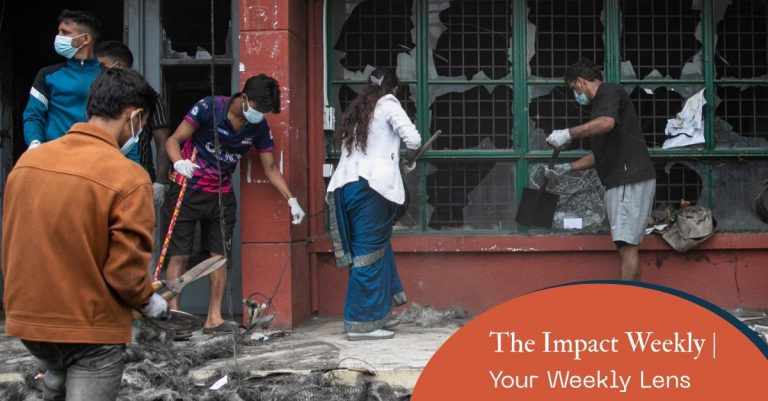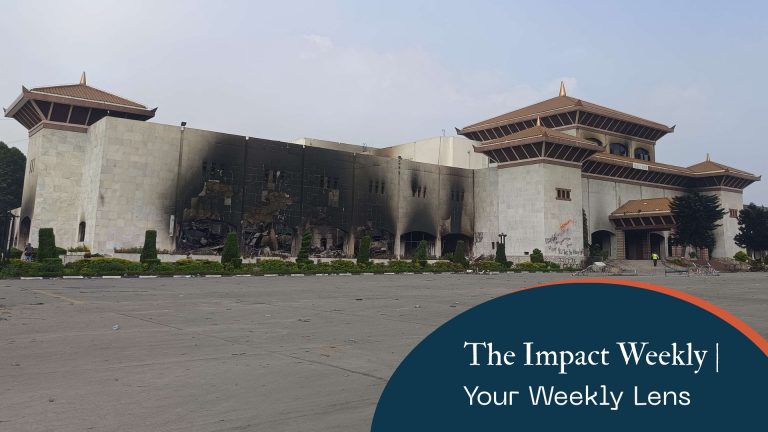The torrential rainfall that hit Nepal on the 3rd, 4th and 5th October resulted in significant destruction across the country. Caused by a low-pressure system from the Bay of Bengal, which intensified monsoon activity over eastern Nepal, the relentless downpours triggered floods, landslides, and infrastructure damage in the country, mainly in the eastern and southern parts of the country, leading to a significant loss of lives.
Ilam, where 39 people lost their lives, was the epicentre of destruction. The region experienced its highest precipitation in 40 years. On Ashoj 19 (October 5), 332.6 mm of rain was recorded at the Himali Gaun station in Suryodaya Municipality—the highest ever, surpassing the previous record of 320.6 mm set in July 1983.
At the Ilam Tea Estate, 280.2 mm of rain was recorded, marking the heaviest rainfall in a decade. The last comparable figure was 273.2 mm in August 1997. Data from four stations across Ilam confirm unusually high rainfall levels across the district.
The five stations that recorded more than 300 mm of rainfall are:
- Himali Gaun Center, Ilam – 332.6 mm
- Kanyam Tea Estate Center, Ilam – 314.2 mm
- Maduli Center, Parsa – 328.6 mm
- Maheshpur Center, Rautahat – 328.0 mm
- Gaur Center, Rautahat – 315.0 mm
Key impacts:
- 53 have lost their lives across the affected regions. 5 people remain missing — 4 in Rasuwa and 1 in Ilam.
- Ilam District in Koshi Province has recorded the highest number of casualties with 39 deaths. Multiple villages were swept away by landslides.
- Over 5,200 houses in Koshi Province were submerged.
- 12 billion loss estimated in the hydropower sector. Over 10 billion in road infrastructure.
- 47 people remain injured, including 22 men, 15 women, and 10 children.
Rescue and relief efforts
The government will provide immediate relief to flood and landslide victims, following guidelines set by the National Disaster Management Council.
Families of the deceased will receive NRs 200,000. Displaced individuals will get NRs 50,000 for temporary housing—NPR 25,000 upfront and the rest after construction. For permanent homes, the government will offer NRs 500,000 in mountainous areas, NRs 400,000 in hills, and NRs 300,000 in the Terai.
The Nepal Army, Armed Police Force, and Nepal Police have been actively involved in search and rescue operations across 28 affected locations. Despite challenges posed by blocked roads and damaged infrastructure, efforts continue to locate missing individuals and provide assistance to affected communities.
Economic impact: Roads, hydropower, river embankment, and irrigation facilities were damaged
The heavy rainfall caused significant disruption to the country’s hydropower sector.
According to the Independent Power Producers’ Association Nepal (IPPAN), a total of 32 hydropower projects across 10 districts in three provinces were affected. Among these, 17 operational projects with a combined capacity of 180 MW and 15 under-construction projects totaling 338 MW experienced varying degrees of damage.
| Operational | MW | Under-construction | MW |
| Mai Khola | 4.5 | Dana Khola | 50 |
| Mai Khola Cascade | 8 | Siddikhola | 10 |
| Sanima Mai | 22 | Sabhakhola B | 21.5 |
| Mai Cascade | 7 | Hewa Khola | 9.9 |
| Super Mai | 7.8 | Bramhayani | 36.5 |
| Super Mai A | 9.6 | Upper Bramhayani | 15.2 |
| Super Mai A Cascade | 3 | Balefi | 40 |
| Jogmai Khola | 7.6 | Lower Balefi | 22.5 |
| Jogmai Cascade | 5.2 | Langtang River | 20 |
| Lower Jogmai | 6.2 | Irkhuwa River B | 15.5 |
| Mai Beni | 9.5 | Upper Irkhuwa | 14.5 |
| Upper Mai | 9.9 | Upper Big River | 22.5 |
| Mai ‘C’ Cascade | 5.1 | Hidi River | 6.82 |
| Puwa 2 | 4.96 | Khimti 2 | 48.8 |
| Upper Puwa 1 | 3 | Gasali River | 4.5 |
| Hewakhola (Panchthar) | 14.9 | ||
| Likhu 4 (Bagmati Province) | 52.4 |
River and embankment damage
According to the Ministry of Energy, Water Resources, and Irrigation, landslides and flooding along various rivers and streams eroded approximately 1,500 meters of embankments throughout the country.
- Kankai (Jhapa): About 200 meters of embankment along the lower right bank of the Postal Highway in Gaurigunj-2 eroded, submerging roughly 114 houses in Hoklabari village and damaging 500 hectares of paddy fields. In Kuwadi, Jhapa Rural Municipality-2, 200 meters of embankment was washed away, causing losses of NRs 7.5 million.
- Mechi River: Flooding caused damage worth NRs 5 million to structures in various locations.
- Keshaliya River (Biratnagar): Flooding displaced 75 households.
- Kamala River (Siraha-17): Pateruwa embankment sustained damage worth NRs 2.5 million.
- Lalbakaiya River (Rautahat): 60 meters of embankment washed away, inundating 100 hectares of paddy fields.
- Boudimai (Rautahat): 120 meters of embankment damaged, submerging 200 hectares of paddy fields and houses, with losses estimated at NRs 6 million.
- Rato River (Mahottari): Embankments were washed away, causing damage estimated at NRs 80 million.
- Sunkoshi River: Flooding submerged the under-construction dam site of the Sunkoshi Marine Diversion Multipurpose Project.
The Ministry of Agriculture and the Livestock Development (MoALD) is currently taking a stock of damages in the sector.
Floods leave heavy damage to roads
Nepal’s highways and bridges have once again suffered damage due to heavy rainfall and landslides. Mechi Highway suffered the most, while Koshi, Hulaki, Araniko, Kanti, and Narayangarh-Muglin Highways also suffered some serious damage. 17 bridges were also destroyed, and many Bailey bridges and alternative roads remain inoperable.
Multiple reports state that the Ministry of Physical Infrastructure and Transport (MoPIT) estimates the total reconstruction cost for roads and bridges at NRs 10.68 billion, in addition to approximately NPR 1.7 billion required to repair damages from previous years.
Mechi Highway alone will need NRs 1.5 billion to repair, while Koshi, Hulaki, Araniko, Kanti, and Narayangarh-Muglin Highways together require NRs 3.77 billion. Rebuilding 17 permanent bridges will cost NRs 4.52 billion, while Bailey bridges and alternative roads require another NRs 239 million.





